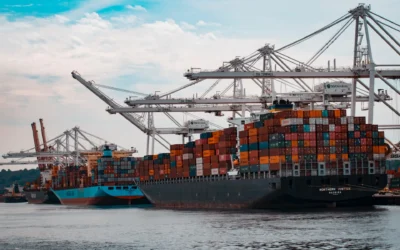5 predictions for
manufacturing in 2022
Manufacturing Trends in 2022
With 2022 here, it’s exciting to imagine what this new year will bring us.
Black swan events like the COVID Pandemic, make us aware of the luxury of having years of stable and predictable growth across the entire manufacturing value chain.
Just like the pandemic accelerated “working from home”, the last two years have also shown the acceleration of some trends in manufacturing. Some of them would’ve probably taken 5 to 10 more years to arrive, but now, they are here to stay and helping us to adapt “to the new normal in manufacturing”.
While the last two years have also shown us, what a difficult exercise it is to predict what is going to happen in the next few months, I spoke with some of our colleagues at Intretech and also some customers, to understand their vision.
Here are some of their predictions for manufacturing in 2022:
Prediction 1:
Manufacturing explores new frontiers.
Asia has been the world’s manufacturing hub for a number of decades now. The lower cost of production enabled by cheap and abundant labour, land and raw materials, along with the ability to efficiently move finished goods globally, has meant “local” manufacturing has not been able to compete with the landed cost of Asian derived products
I spoke with Intretech Global’s CEO, Lin Songhua and he believes that in 2022 this trend will accelerate.
More and more manufacturers in China will go outside to set up factories. The hottest area is South-East Asia, with Eastern Europe showing to be a rising, manufacturing destination.
However, emerging economies do not always have the infrastructure required to maintain a fit and healthy workforce. As big global manufacturers continue their expansion outside of China, they will also help with upskilling workers in these new destinations.
Prediction 2:
Logistics rises back from the ashes
In the last couple of years we’ve seen a collapse in the worldwide logistics.
The significant delays caused by the congestion of the US West and East coast ports, have increased by more than 80% the time it takes a container to travel from China to the US.
This shows a bottleneck that is present in a lot of the main ports around the world. China has mastered the art of shipping products, but the world hasn’t caught up to this.
Covid helped expose the weaknesses in the supply chain, but it wasn’t the main culprit. Underlying challenges had been accumulating for years and the pandemic simply accelerated them.
Ashley Sayed CEO of Intretech UK believes that:
In 2022 we will have to rely more on AI and digitalisation of the supply chain. We have to keep moving towards an end to end digitalisation and automation of the global logistics sector. We will see more warehouses moving from mostly manual operations into a mixed model, to then full automation
As with other areas of manufacturing, automation in logistics will help reduce the reliance on human operators. Many tasks can now be performed much quicker and safer by automated solutions.
“In 2022 we will start to see more logistics solutions leveraging IoT technologies. Along with Artificial Intelligence and analytics, this will help identify bottle necks in the supply chain even before they happen. This will also allow us to plan better rather than simply react”
Prediction 3:
Accelerated Onshoring
In more recent years, with wages rising in China, we are seeing a shift to other emerging economies within Asia such as Vietnam, Thailand and Malaysia, who could provide more competitive pricing for labour intensive manufacturing.
During these times, the only companies able to leverage benefits from “local” manufacture were multi-nationals, for whom the cost of moving large volumes of finished goods around the globe negated the advantages gained in centralised manufacture within Asia.
However the pandemic has forced us to re-evaluate our supply base. I spoke with my colleage Zifeng Wei, Vicepresident at Intretech’s manufacturing facility in Hungary, he believes that:
In 2022 companies will restructure their global supply chain setup, with a heavy focus on automation and robotics to offset the potential higher cost of a localized manufacturing
There will be an impact on pricing, so the onshore shift may not be a complete withdrawal from Asian supply. It is more likely to be a percentage shift to establish a local presence that could be ramped up, should other supply routes be affected.
It is very common for companies to second source within the supply chain, however moving forwards the physical location of the second source will come to prominence in terms of selection, again with a drive to onshore suppliers.
Manufacturing automation will be critical to help keep the costs low when onshoring.
Through automation, we can offset the higher costs of labour, when using non asian manufacturing. This makes on-shoring feasible and profitable.
Prediction 4:
Sustainability: No longer a “Nice to have”
According to IPSOS 2022 Global predictions: “Most people around the word believe in 2022 we will see more climate change consequences”. https://www.ipsos.com/en/global-predictions-2022

In 2022 we will start to see manufacturing taking this topic seriously. Sustainable manufacturing is no longer a “nice to have”.
I spoke with Stefanos Knonandreas, Design for Service Manager at Philip Morris International, about his views of what’s going to happen in manufacturing in 2022.
Manufacturing has a big role to play, to make sure that we can slow down global warming and also reduce supply chain risks. According to the World Economic Forum there are 3 key areas where manufacturing can help:
- Improving resource efficiency in manufacturing processes is as important as reducing the transport industry’s greenhouse gas emissions;
- Setting high emission reduction targets is the only way towards a net-zero greenhouse gas economy;
- Reducing the industry’s reliance on fossil fuels, recycling components and adopting more environmental design practices will be critical, as will insisting on a better way of working across the value chain.
Prediction 5:
Microfactories go big.
In 2012, the Government Office for Science published a report called “The Future of Manufacturing: A new era of opportunity and challenge for the UK”(https://www.gov.uk/government/collections/future-of-manufacturing). Amongst IoT and Automation, one of the key trends identified was “the rise of more mobile and modular manufacturing.”
“factories would be more agile – able to adapt quickly to changing customer demands. This would be enabled by advances in technology such as additive manufacturing and artificial intelligence, and shorter supply chains would be driven by external shocks .”
Microfactories, allow manufacturers to bring their production closer to where their consumers are. It also needs a very small footprint for deployment, reducing intercontinental shipping costs of products, as a result, minimising CO2 emissions involved with transport.
Ashley Sayed, CEO Intretech UK, predicts that in 2022, we will start to see a big shift towards leaner manufacturing, specifically repurposing manufacturing equipment.
“There will still be a use case for those large scale, mass production manufacturing lines. We are working with some customers to help build, automate and scale them for the next few years. But more and more we see a growing interest from our customers when we talk to them about microfactories. In 2022 we will be deploying our first microfactory cells…”
These modular systems are also built for assembly and disassembly, allowing manufacturers to reuse their same manufacturing lines for servicing and recycling parts of their products.
The move to automation will come from a drive to mitigate the risk of not having personnel available to manufacture products – cheap labour is only a benefit if that labour is available.
The knock-on effect of introducing automation is that it opens-up greater onshoring possibilities in terms of both location and volume – fewer personnel required to manufacture finished goods also directly impacts the benefits attributed to lower labour costs in Asia.
By introducing automation on a modular platform it is possible to open-up automation to a wider market than a more traditional, bespoke system, it also allows for faster implementation, greater flexibility and simplified scalability.
“As these micro-factories start to get installed in factories around the UK and Europe, they will be on-shoring products currently manufactured abroad. They will also allow the training of workers to state of the art automation systems, up-skilling the manufacturing workforce around the country.”
Ashley Sayed.
Overall, while things may never go back to how they were before the pandemic, this may not be a bad thing after all. These shocks to the system help accelerate change and innovation. Based on our conversations with people from the industry I’m confident we will come out stronger on the other end, more resilient and adaptable.
2022 will be an exciting year. In the meantime, what do you think 2022 will bring to manufacturing? Send me your predictions to steve@intretechuk.com, I’d love to read and discuss them.
Explore more related content
12 reasons why Microfactories are the future of manufacturing
12 reasons why Microfactories are the future of manufacturingMicrofactories: The Future A few days ago, Peter Goodman...
Your products aren’t designed for automation. This is costing you millions
Your products aren’t designed for automation. This is costing you millions.As product designers and engineers, we are...
6 Takeaways from the European Commission’s 2022 Green Deal.
6 Takeaways from the European Commission’s 2022 Green Deal.Last week, the European Commission presented a new package...



